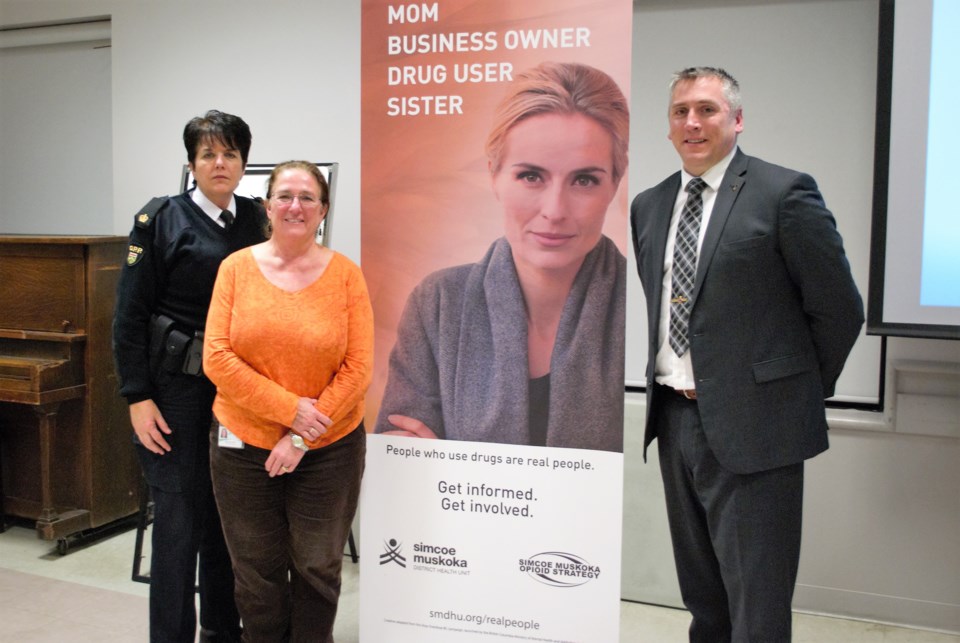An ad campaign, aiming to put a new face on the issue of opioid addiction in Simcoe County, was unveiled at a public open house in Collingwood on Wednesday night.
The campaign, revealed by the Simcoe Muskoka District Health Unit, shows a woman with the words “Mom, business owner, drug user, sister,” at the top.
“That really is the face of what we are seeing,” said Mary Kocher, public health nurse with the Simcoe Muskoka District Health Unit. “We hear of really successful people that ended up with an injury or surgery and we’ve lost them because they were prescribed an opioid for pain management and became addicted.”
“It’s hard for us to really understand the level at which this has taken over these individual’s lives. But that’s what we’re seeing,” said Kocher.
Kocher talked about the role stigma can play, which has prevented some who are using from seeking treatment, which the advertisements are looking to combat.
“There’s a lot of labels and stigmatizing... it’s a major barrier to accessing social services,” said Kocher. “Someone who has stigma in their life is less likely to follow through with a treatment program out of fear. It causes many feelings of anger, shame and rejection. We can reduce it by talking openly about substance use and disorders.”
Formed in May 2017, the Simcoe Muskoka Opioid Strategy (SMOS) is a regional partnership and collaborative effort to address the opioid issue in the area. Its ‘action pillars’ include prevention, treatment/clinical practice, harm reduction, enforcement and emergency management. The ‘foundational pillars’ on which SMOS is based are lived experience, data and evaluation.
When it comes to opioid deaths, the hardest-hit areas in Simcoe County are Barrie, Orillia and Midland. In 2013 and 2014, there were 23 deaths in Barrie, 11 in Orillia and less than five in Midland. In 2015 and 2016, those numbers nearly doubled for Barrie (44) and Midland (nine), while Orillia fell to nine.
Between January 2016 and June 2017, the number of opioid overdose visits to a hospital by Collingwood residents was 15.
Det.-Insp. Jim Walker of the OPP organized crime enforcement bureau indicated at the open house that while opioid use has not been decriminalized, the OPP has turned its attention from users to dealers in an effort to stop the illicit drugs from coming into the area in the first place, specifically fentanyl and carfentanyl.
Walker referenced a recent Barrie drug trafficking case that saw five people who consumed cocaine laced with fentanyl all overdosing in one night in Barrie’s downtown core. The dealer in that case was recently sentenced to eight years in jail.
“Eight years for trafficking or importing in Canadian courts is substantial,” said Walker. “Our Crown (Attorneys) from 2014 on have been very aggressive with this.”
“People always say, ‘How did we get here? How did we end up with this problem?’ Heroine has been around for decades. When I started there was a very tight group who used heroine and they knew their suppliers. They knew, for the most part, their dosages,” said Walker. “With the introduction of oxycodone and oxycontin... it ended up on the market (too).”
Walker said that the OPP will be undergoing anti-stigma training in the new year.
“You have many people who were off on a back injury and were prescribed this, but then became addicted to it, unfortunately,” he said. “When they’re cut off they migrate to another (drug).”
“These are people. Brothers, sisters... it’s a different animal from other illicit drugs,” said Walker. “People who actively use are seeking out fentanyl because it’s cheaper and more powerful.”
While the situation is dire, Walker has seen strides over the past year or more when it comes to awareness.
“Two years ago, to find a Naloxone kit in a residence when executing a search warrant was unheard of. Now, we see Naloxone kits or evidence of partially used Naloxone kits in every residence I’ve been in for an investigation... probably for the last six months,” he said. “The programming from the health unit and the provincial government, getting those kits out there, is effective.”
For more information on the SMOS, visit preventOD.ca.



